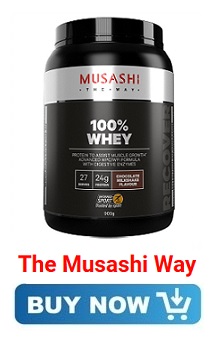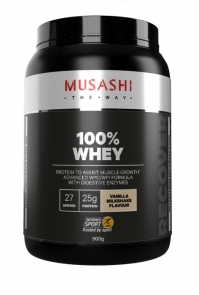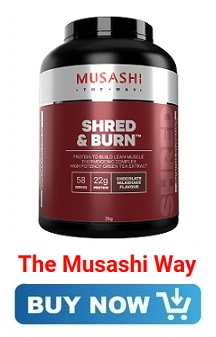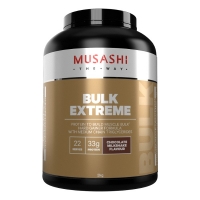Musashi Protein Review
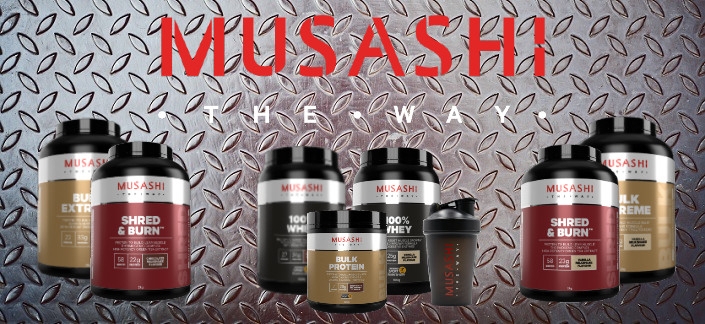
Musashi has been one of the top names in Sports Nutrition since their inception in 1987. Their products are used by a range of people from the health focused to weekend gym enthusiasts and novice athletes to the elite level.
Musashi sponsor a range of sporting teams, including the Melbourne Storm (NRL) and the Western Bulldogs (AFL), and professional athletes, such as UFC middleweight Champion Rob Whittaker and professional MMA and Kickboxer Carlos Ulberg.

Musashi proteins are some of the most popular whey powders in Australia. The brand name has become synonymous with quality and consistency, two things that consumers hold in high regard when selecting their protein.
This sports nutrition company also offers a range of protein bars, intra-workouts, pre-workouts, amino acids and functional mineral and herbal products.
Musashi Protein
When was the last time you had a protein shake? Maybe you’ve got one in your hand right now. If so, kudos to you!
If not, think back. Maybe it’s been a while?
Perhaps you took one post-workout. Maybe you jammed a serve into your breakfast smoothie. Some take protein shakes when time is of the essence and a stop for lunch is looking as probable as Homer Simpson eating an apple.
We consume protein shakes for a wide range of reasons, well above and beyond the common belief that protein powders must equate to an obsession with muscle.
For most, protein shakes are part of a post-workout ritual. And this can be a great reward, especially when the flavours are decadent. But did you know that this is not the only way you can use a quality protein powder?
Let’s hypothesize for a minute. Even if you ditched the post-workout protein shake for a meal containing quality protein food, scrapped the before bed shake or breakfast smoothie addition, there are still great ways to use protein powders.
For building or maintaining muscle mass, a great way to use protein shakes is as a morning tea and afternoon tea snack.
Most people don’t have much trouble getting down 3 squares per day with a quality protein source. I.e., breakfast, lunch and dinner with foods like egg, lean meats, seafood and dairy.

And in terms of muscle maintenance and growth, that’s great. However, there’s a pretty big gap between the main meals where blood amino acid levels drop. And once this happens our anabolic or muscle-building signals become weaker.
So to keep our blood essential amino acid levels topped up is a good thing when it comes to muscle gain or maintenance as we age. This is why so many people are adopting the small meals frequently eating plan, like Dwayne Johnson (The Rock) and Mark Wahlberg.
A small protein shake in water at around the 10am mark, followed by an afternoon tea shake at around 4:00pm (depending on when you eat your main meals) will only contribute about 250calories or so to your daily energy intake, yet help to keep your muscle mass well supported.
And lean muscle mass is an important marker of overall health.
Protein is Super-Important: Fad, Fact or Myth?
Protein, protein, protein! No macronutrient has ever been quite so popular.
Is it simply because we know we need protein in order to gain muscle and build the body of our favourite movie star?
Or is there more to it than that?
Protein supplies us with foundational nutrients for health—ones we can’t survive without: the essential amino acids.
There are 9 essential amino acids, which are:
* Branched Chain Amino Acids (BCAAs)
So these individual amino acids must be pretty important if we can’t survive without them, right?
You bet.
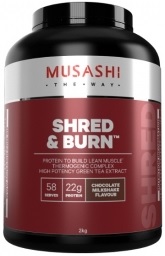 The essential amino acids are needed for all sorts of processes in the human body. Some are built into proteins, which are chains of amino acids linked together by peptide bonds. These form the structure of tissues like bone, muscle and skin.
The essential amino acids are needed for all sorts of processes in the human body. Some are built into proteins, which are chains of amino acids linked together by peptide bonds. These form the structure of tissues like bone, muscle and skin.
Other roles are not based providing structure for protein, like Tryptophan. In fact, tryptophan is the only essential amino acid that is not used at all to create protein structure in the body. However, this does nothing to diminish it’s importance!
Tryptophan is needed for the creation or Serotonin, most of which is found within the GUT (1). A small amount is located in the brain, where it is needed to support a healthy mood and regulate sleep and brain health through Melatonin.
Leucine is receiving a lot of attention of late, as it has been shown to trigger mammalian target of rapamycin (mTOR), which is needed for protein synthesis (2). Therefore, leucine is an important facilitator of muscle growth and maintenance when taken with the other EAAs.
Protein also delivers conditionally-essential amino acids, like tyrosine and glutamine, and non-essential amino acids, like serine and alanine. It’s worth noting that research is suggesting we don’t necessarily need these in supplemental form for protein synthesis, as the body recycles them from muscle quite efficiently (3). However, they’re still good to have on hand, especially if you’re training hard and your muscle are growing quickly!
Every nutrient has its day, rising to popularity above all else. And though protein will no doubt lose some of its fanfare over the coming decades, it certainly does deserve every bit of the attention it’s receiving.
Protein may well be a fad, but its importance is not a myth—that’s a fact. Protein is believed to be the most important nutrient after water and oxygen (if you can call this a nutrient).
Is Musashi Protein Banned Substance Free?
 Musashi products, including Musashi Protein powders, are Informed Sport Certified. This means that every batch of raw materials and/or finished product are tested for banned substances by LGC’s world-class sports anti-doping laboratory.
Musashi products, including Musashi Protein powders, are Informed Sport Certified. This means that every batch of raw materials and/or finished product are tested for banned substances by LGC’s world-class sports anti-doping laboratory.
This certainly takes the guess work and worry out of your supplementation, especially if you are a competitive athlete.
Is Musashi Protein Powder Safe?
The main concerns that arise with protein supplements are the same as quality protein food—individual allergies and intolerances.
For instance, if you are allergic to milk protein, then you will need to avoid dairy-based protein powders. In this instance you would be better suited to a plant-based product, though check the allergen declaration to be sure.
Most people who are lactose intolerant can consume up to 13 grams of lactose spread throughout the day without symptoms. For the sake of comparison, each serve of Musashi 100% Whey contains 2.1 grams of lactose, while Musashi Shred and Burn contains 3.9g lactose per serve. If you are lactose intolerant, it would be best to avoid Musashi Bulk Protein and Musashi Bulk Extreme altogether.
If you are extremely caffeine sensitive, avoid Musashi Shred and Burn, as each serve contains 99mg of caffeine which is equivalent to approximately 1 cup of coffee.
There seems to be one major organ that some people worry about when it comes to protein powder supplements: the kidneys.
An article was recently published by Nutrients (2019) which examined in-depth the relationship between protein intake and health, with a focus on kidney function.
The authors concluded that in the general population who have normal kidney function, there was no noticeable relationship between protein intake and declines in kidney function (4).
However, in people with reduced kidney function, protein intake does need to be limited to less than 0.8 grams per kilogram of ideal bodyweight per day.
This study also highlighted the importance of keeping protein intake up (unless you have impaired kidney function). In fact, the researchers demonstrated that if healthy individuals let our daily protein intake drop below 0.8g/day per kg of ideal body weight, all-cause mortality (excluding cardiovascular disease) goes up.
Which Musashi Protein Powder Suits Your Needs?
Lean Muscle Gain: 100% Whey or Shred and Burn
Mass Gains: Bulk Protein or Bulk Extreme
Endurance: 100% Whey
Weight Loss: Shred and Burn
Muscle Maintenance/Supplement Diet: 100% Whey
Musashi 100% Whey
This is a quality blend of whey protein isolate and whey protein concentrate, creating one of the best value whey protein powders on the Australian market.
This is a multi-purpose powder with fast absorption (yes, there is little difference in absorption rates between WPC and WPI!) that may be taken after exercise, between meals, added to smoothies
Each serve of chocolate contains 24.4 grams, while vanilla flavours contains 25.3 grams of protein per serve. Musashi 100% Whey contains around 130 calories per serve.
Whey protein is considered to have the highest biological value of any protein powder or food. This is due to its high content of essential amino acids with plenty of leucine, and its rapidity of absorption.
When to Use Musashi 100% Whey (and How)
This product can be used after exercise to facilitate recovery. It may also be used between meals as a snack, or you can take it with a low protein meal. Musashi 100% Whey also blends well into smoothies to create a delicious protein-rich drink.
For a mass gaining program, try 1.5 to 2 scoops per serve. For endurance athletes, use ½ scoop with carbohydrates after exercise. A standard serve for everyone else is 1 scoop.
Musashi Shred and Burn
Gaining muscle is easy when there’s no calorie cap. Unfortunately, this approach typically leads to an appreciable amount of fat gain as well.
This is where Musashi Shred & Burn steps into the equation. Whether you are shedding some unwanted mass gains body fat or simply wanting to shed some pounds, this is a low calorie protein with added fat metabolisers to help you get there.
Each serve delivers quality dairy-protein with L-Carnitine, Choline, Green Tea Extract and Green Coffee Extract to support a healthy metabolism and facilitate weight loss.
How to Use Musashi Shred and Burn
Mix 1 scoop into cold water and consume. You might like to try taking this product to replace either breakfast or lunch with a small palm full of raw nuts and a piece of fruit.
Alternatively, it may be taken after exercise to support recovery or used as a snack for morning or afternoon tea.
Importantly, be aware that each serve contains 99mg of caffeine. If you are quite sensitive to caffeine, you may need to start with a half serve taken before lunch so as to maintain quality sleep.
Musashi Bulk Protein
Few mass products have survived the sheer onslaught of market competition quite like this Musashi Protein Mass Gainer. That’s because it keeps it simple, offering value, effective ingredients and quality flavour.
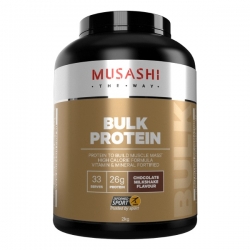 And flavour certainly is important on a mass gains program. After all, we have to be able to chug down these shakes time and time again.
And flavour certainly is important on a mass gains program. After all, we have to be able to chug down these shakes time and time again.
Musashi Bulk Protein contains a range of dairy-sourced proteins, including whey protein concentrate, skim milk powder, whey protein isolate and whole milk powder. This means you’re getting the 2 premium proteins found in milk: whey and casein.
On top of this, Musashi have added a vitamin and mineral blend to cover some of your micronutrient bases, as well as maltodextrin and dextrose carbohydrate sources.
This Mass Gainer from Musashi Protein delivers slightly more protein than carbohydrates in each serve, and around 225 Calories.
How to Use Musashi Bulk Protein
Mix 4 rounded scoops (60g) into 500ml skim milk or 300ml water and shake. If you want to boost your calories even higher, use full cream milk.
500ml of full cream milk provide 540 calories, along with 19 grams of protein and 69 grams of carbohydrates. In addition to 1 serve (60g) Musashi Bulk Protein Chocolate, this would create a shake delivering 757 calories, 45 grams of protein and 92 grams of carbohydrates.
Musashi Bulk Extreme
This Musashi Protein Mass Gainer delivers more than Musashi Bulk. That is, more protein, carbohydrates and fats in the form of Medium Chain Triglycerides (MCTs). This is definitely the Musashi Protein staple for the hard gainer.
MCTs are specialised fatty acids that are readily converted to energy and may even assist with focus and concentration. These fats are naturally found in coconut oil and palm kernel oil.
This product provides whey and casein dairy proteins along with maltodextrin as a carbohydrate source. The carbohydrate to protein ratio is a little higher in Musashi Bulk Extreme than in Bulk Protein. And with the addition of the energy-promoting MCTs, this is a product to boost recovery and help you train to the absolute max in the gym.
How to Use Musashi Extreme Bulk
Mix with 500ml of skim milk or 300ml water, shake and consume. Take up to 2 serves daily. For a higher calorie and protein level, try mixing with full cream milk.
Conclusion
Musashi have been forging new paths in sports supplementation since 1987. Their range of banned substance free protein powders are not only budget-friendly, but offer quality nutrition in a range of pleasant-tasting shakes.
Musashi 100% Whey is perhaps one of the most budget-friendly whey protein powders on the Australian market. With affordability and premium nutrition on their side, Musashi Protein powders still stand out amidst a sea of competing products—even after more than 30 years.
References
Header Background Image Courtesy of Yinyang at FreePik.



